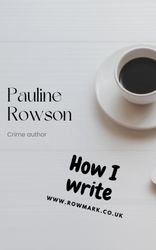
When I began writing I made the mistake of thinking the first draft was the final one. I was so thrilled at having finished my book that I thought that was it, when in reality it was only the beginning.
The first creative draft is often the most enjoyable and the most painful because I have so much in my head that I want to get it onto my computer screen as quickly as possible. This is hindered, because at that stage I have no idea who done it, why and how! I also research as I write so that can stop the flow but it can also aid it because the research can throw up new plot ideas and characters. At last (usually after three months for me) there comes a time when I have approximately 80k words on my computer. Then the revisions begin.
I usually go through eight revisions before sending my MS off to my wonderful editor at Joffe books with my fingers crossed that she likes it and the crime novel all hangs together.Once the revisions begin there are a number of key questions that I ask myself as I go through the manuscript.
Every scene or linking passage must be there for a reason. I ask:
Why is this scene included?
What is there about it that will make the reader read on?
Does it start at the right point?
Does it end at the right point?
Is there a good blend of narrative, description and dialogue?
I look critically at too long explanatory passages – can they be expressed in a different way? Can I show readers what is happening and what my characters are thinking. I do a lot of character internal thinking in my novels, especially as I write from the single male point of view. How would Andy Horton, or Art Marvik, or Inspector Ryga react and think? What would each do in the situation they’re facing?
My crime novels are multi-layered, so I usually have subplots running through them. I therefore need to check if they are sufficiently interwoven. Do they aid the story, do they add to the characterisation? Are they there as a red herring or do they blend or help solve the main plot?
Do the events grow out of one another? Is there cause and effect? Is there sufficient conflict? Is there sufficient variety? Is there a change of pace? Is the plot clear? Is the story credible? Have I made it credible even if it is incredible?
When I get to final revisions I look at the wording and phrasing. Does each sentence say what I intended it to say? Is it elegant or clumsy? A good copy editor will highlight areas that need fine tuning, and can also suggest substituting words and phrases that work better.
I also go through it for phrases and words I overuse. (Every author has their favourites that keep cropping up e.g. words like smile, grin, frown).
And finally have I surprised the reader? Does the novel entertain? I sincerely hope so.
Pauline Rowson lives on the South Coast of England and is the best selling author of many crime novels, published by Joffe Books. Her popular crime novels include the DI Andy Horton Solent Murder Mystery series, the Art Marvik mystery thrillers and the 1950s set Inspector Ryga mysteries. Subscribe to her newsletter for all the latest books news.